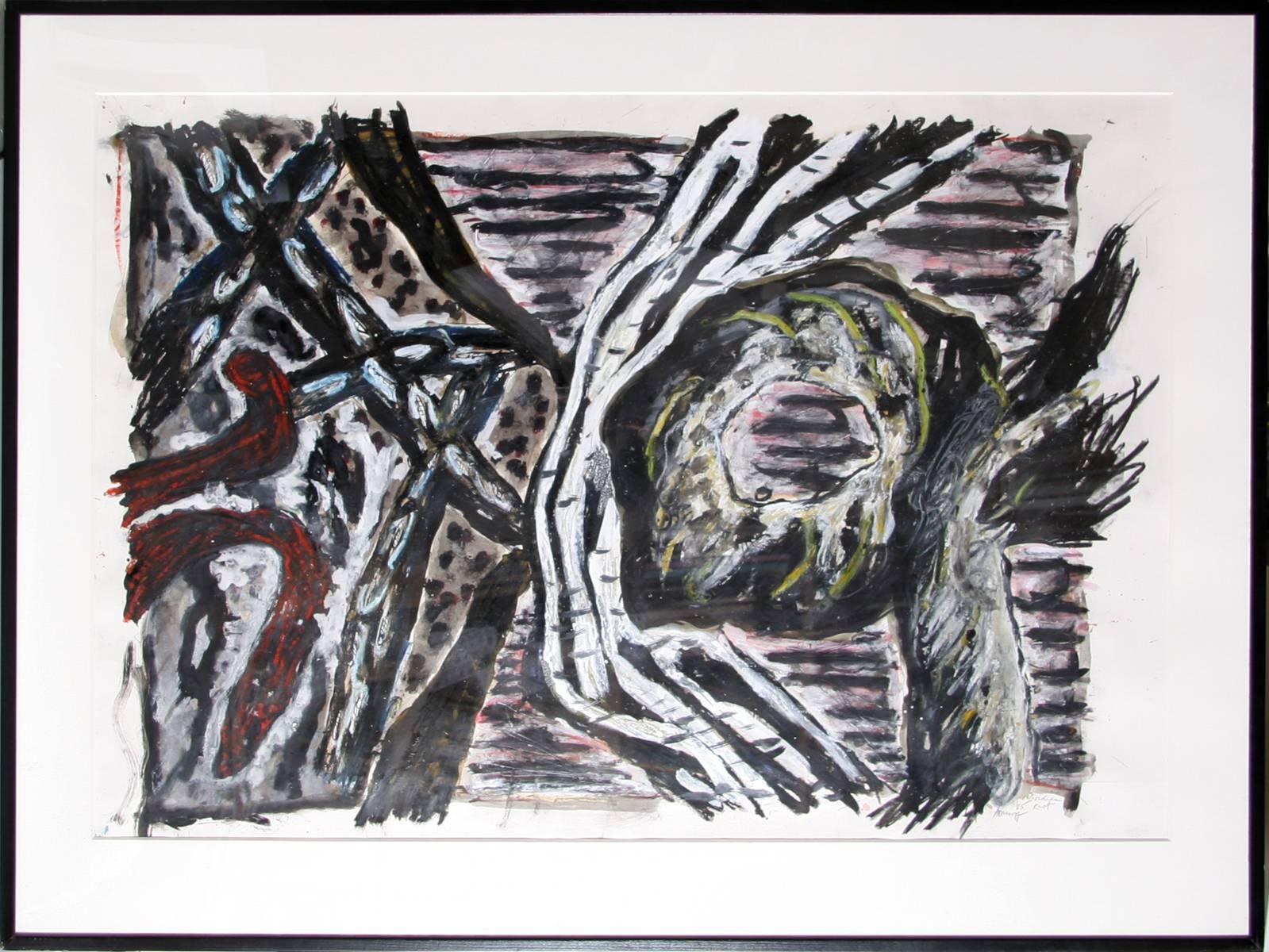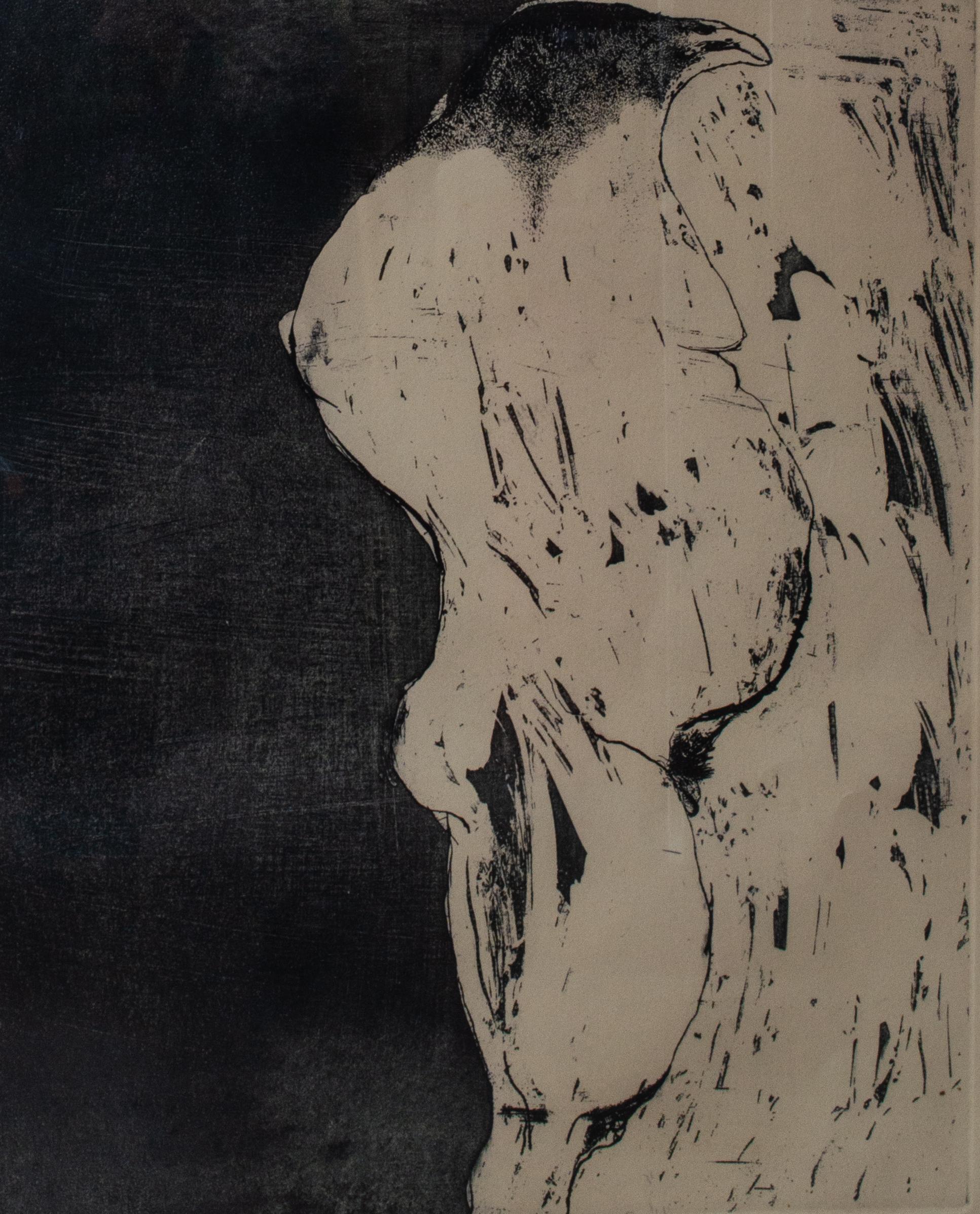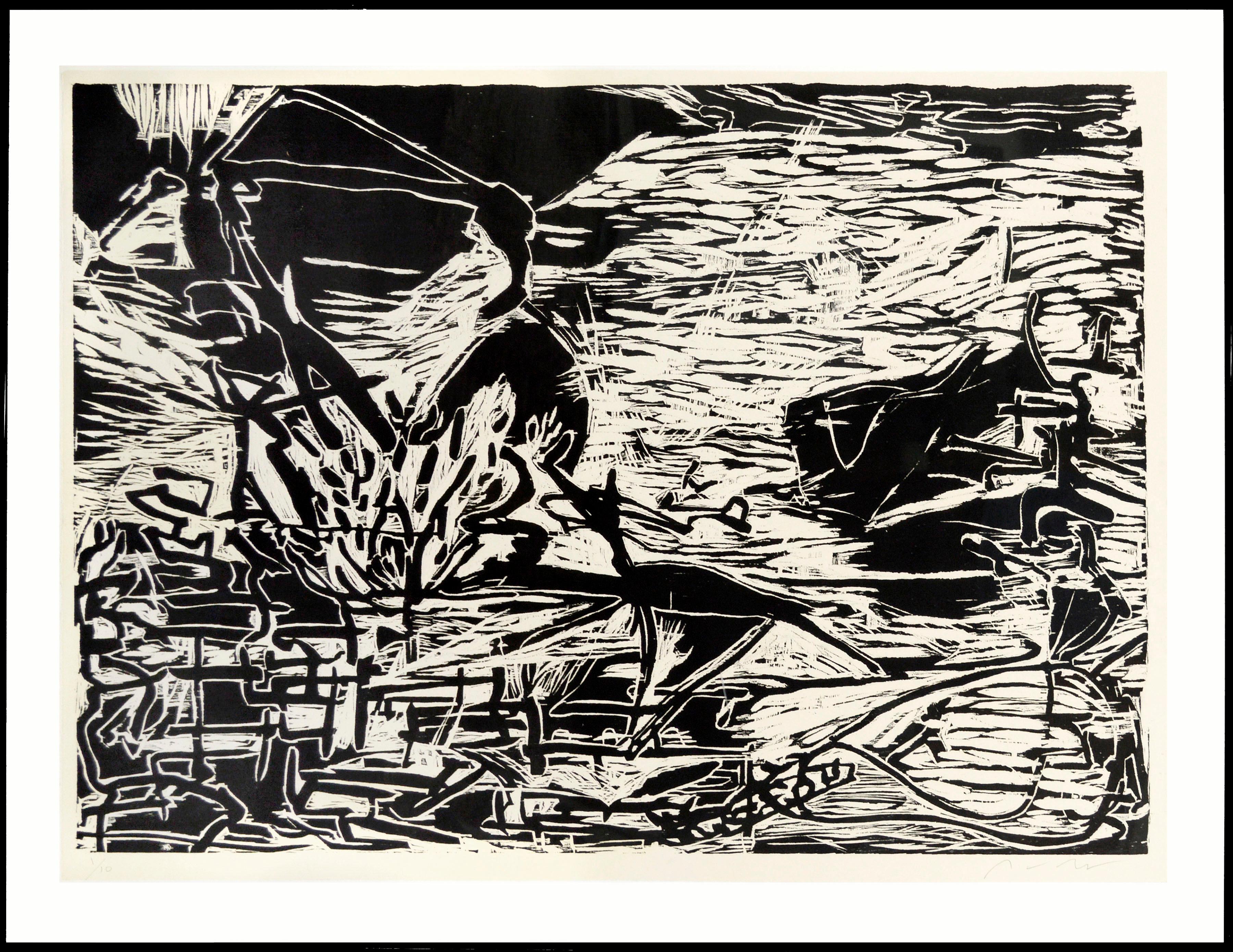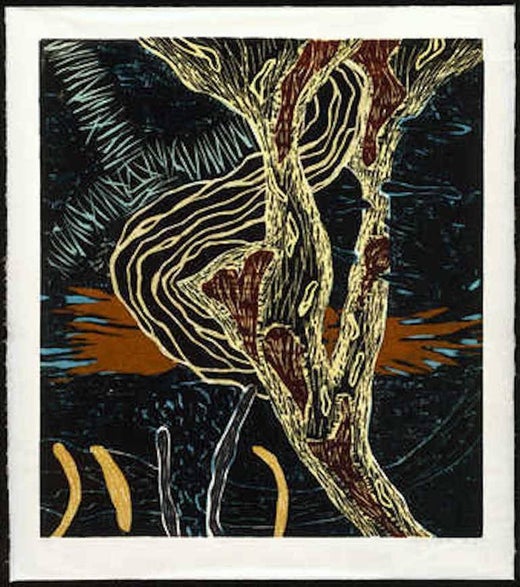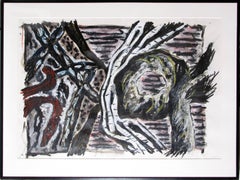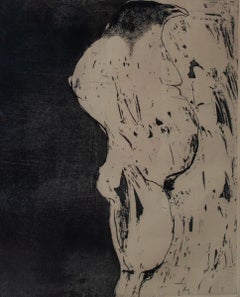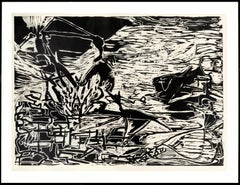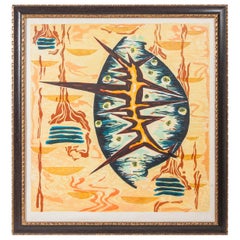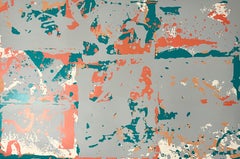Items Similar to Gnarl, Large Framed Abstract Expressionist Woodcut by Gregory Amenoff
Want more images or videos?
Request additional images or videos from the seller
1 of 6
Gregory AmenoffGnarl, Large Framed Abstract Expressionist Woodcut by Gregory Amenoff1987
1987
$3,400
£2,649.26
€3,005.50
CA$4,886.56
A$5,380.58
CHF 2,790.06
MX$63,720.83
NOK 35,418.09
SEK 33,102.22
DKK 22,447.56
About the Item
Artist: Gregory Amenoff, American (1948 - )
Title: Gnarl
Year: 1987
Medium: Woodcut and Screenprint, Signed and numbered in Pencil
Edition: 35
Image Size: 41 x 36 inches
Frame: 52 x 47 inches
- Creator:Gregory Amenoff (1948, American)
- Creation Year:1987
- Dimensions:Height: 41 in (104.14 cm)Width: 36 in (91.44 cm)
- Medium:
- Movement & Style:
- Period:
- Condition:
- Gallery Location:Long Island City, NY
- Reference Number:Seller: RO719241stDibs: LU4663458063
Gregory Amenoff
Gregory Amenoff is a painter who lives in New York City and Ulster County, New York. He is the recipient of numerous awards from organizations including the American Academy of Arts and Letters, National Endowment for the Arts, New York State Council on the Arts and the Tiffany Foundation. He has had over fifty one-person exhibitions in museums and galleries throughout the United States and Europe. His work is in the permanent collections of more than thirty museums, including the Whitney Museum of America Art, the Museum of Fine Arts in Boston, the Museum of Modern Art in New York and the Metropolitan Museum of Art.
About the Seller
4.9
Platinum Seller
Premium sellers with a 4.7+ rating and 24-hour response times
Established in 1979
1stDibs seller since 2014
3,170 sales on 1stDibs
Typical response time: 1 hour
- ShippingRetrieving quote...Shipping from: Long Island City, NY
- Return Policy
More From This Seller
View AllGuardian Knot, Large Abstract Painting by Gregory Amenoff
By Gregory Amenoff
Located in Long Island City, NY
Artist: Gregory Amenoff, American (1948 - )
Title: Guardian Knot
Year: 1985
Medium: Oil, Oil pastel, Watercolor, Gouache and Pencil on Paper, signed and dated l.r.
Size: 36 x 51.75 i...
Category
1980s Abstract Mixed Media
Materials
Acrylic, Oil, Watercolor, Gouache
"A" Signed Abstract Woodblock Print by Charlie Hewitt
By Charlie Hewitt
Located in Long Island City, NY
Artist: Charlie Hewitt, American (1946 - )
Title: Untitled - A
Year: circa 1995
Medium: Woodblock, Signed and Numbered in Pencil
Edition: 80
Image Size: 16 x 20 inches
Size: 20 in. x...
Category
1990s Abstract Expressionist Abstract Prints
Materials
Screen
Final Hours, Abstract Lithograph by Gregory Amenoff
By Gregory Amenoff
Located in Long Island City, NY
Artist: Gregory Amenoff, American (1948 - )
Title: Final Hours
Year: 1986
Medium: Lithograph, Signed and numbered in Pencil
Edition: 40
Paper Size: 37 x 38 inches (93.98 x 96.52 cm)
Category
1980s Abstract Abstract Prints
Materials
Lithograph
"I" Abstract Woodblock Print by Charlie Hewitt
By Charlie Hewitt
Located in Long Island City, NY
Artist: Charlie Hewitt, American (1946 - )
Title: Untitled - i
Year: circa 1995
Medium: Woodblock, Signed and Numbered in Pencil
Edition: 100
Image Size: 16 x 20 inches
Size: 18.5 x ...
Category
1990s Abstract Expressionist Abstract Prints
Materials
Screen
Untitled - G, Abstract Expressionist Woodcut by Charlie Hewitt
By Charlie Hewitt
Located in Long Island City, NY
Artist: Charlie Hewitt, American (1946 - )
Title: Untitled
Year: circa 1995
Medium: Woodblock, Signed and Numbered in Pencil
Edition: 100
Image Size: 16 x 20 inches
Size: 20 in. x 24...
Category
1990s Abstract Abstract Prints
Materials
Woodcut
"J" Abstract Woodblock Print by Charlie Hewitt
By Charlie Hewitt
Located in Long Island City, NY
Artist: Charlie Hewitt, American (1946 - )
Title: Untitled - J
Year: circa 1985
Medium: Woodblock, Signed and Numbered in Pencil
Edition: 100
Size: 20 in. x 24 in. (50.8 cm x 60.96 cm)
Category
1980s Abstract Expressionist Abstract Prints
Materials
Screen
You May Also Like
Leonard Baskin Abstract Woodcut, Signed
By Leonard Baskin
Located in New York, NY
Leonard Baskin (1922-2000)
Untitled, Late 20th Century
Woodcut
Framed: 32 x 24 1/4 x 1/4 in.
Edition 26/50
Signed and numbered lower right
A highly respected draftsman, printmaker, ...
Category
Late 20th Century Abstract Abstract Prints
Materials
Woodcut
Large Scale Abstract Figurative Landscape Woodcut, Signed Limited Edition 1/10
By Michael Pauker
Located in Soquel, CA
Large scale limited edition woodcut print of an an abstracted scene with landscape elements and rough figural forms including a dog, house and tree that emerge from chaotic linear ab...
Category
Late 20th Century Post-War Abstract Prints
Materials
Paper, Woodcut, Ink
Large Woodblock Print by Gregory Amenoff
Located in New York, NY
Very large format wood block painting mounted in a carved black and gilt frame. Signed.
Category
Vintage 1980s American Modern Decorative Art
Materials
Wood
Large Mandragora Abstract Expressionist Screenprint Lithograph Darby Bannard
By Walter Darby Bannard
Located in Surfside, FL
Walter Darby Bannard (born 1934 in New Haven, CT)
Mandragora
Silkscreen Litho print on BFK Rives art Paper. Hand signed in pencil, numbered and titled.
Walter Darby Barnard is a Pr...
Category
1980s Abstract Abstract Prints
Materials
Mixed Media
Untitled, expressionistic woodcut print, from the Art Against AIDS Portfolio
By James Bettison
Located in New York, NY
James Bettison
Untitled, from the Art Against AIDS Portfolio, 1988
Woodcut on paper with deckled edges. Hand signed. Numbered 38/50. Dated. Printer's and Publisher's Blind Stamp.
20...
Category
1980s Contemporary Abstract Prints
Materials
Woodcut, Pencil
"India, " Abstract Woodcut and Monotype signed by Carol Summers
By Carol Summers
Located in Milwaukee, WI
"India" is a woodcut and monotype signed by Carol Summers. Here, Summer's abstract language for landscape imagery is taken to its most extreme: The image offers a view of a highly stylized waterfall, with red water falling down behind green foliage below. A hint of light blue at the lower left suggests a continuation of the water's flow. Above, purples and yellows mist upward from the power of the water. The playfulness of the image is enhanced by Summers' signature printmaking technique, which allows the ink from the woodblock to seep through the paper, blurring the edges of each form. Summers' signature can be found in pencil at the bottom of the rightmost blue form, with the title and edition at the bottom of the leftmost blue form. A copy of this print can be found in the collection of the Fine Arts Museums of San Francisco.
37.25 x 24.88 inches, artwork
48.5 x 35.5 inches, frame
Numbered 44 from the edition of 75
Carol Summers (1925-2016) has worked as an artist throughout the second half of the 20th century and into the first years of the next, outliving most of his mid-century modernist peers. Initially trained as a painter, Summers was drawn to color woodcuts around 1950 and it became his specialty thereafter. Over the years he has developed a process and style that is both innovative and readily recognizable. His art is known for it’s large scale, saturated fields of bold color, semi-abstract treatment of landscapes from around the world and a luminescent quality achieved through a printmaking process he invented.
In a career that has extended over half a century, Summers has hand-pulled approximately 245 woodcuts in editions that have typically run from 25 to 100 in number. His talent was both inherited and learned. Born in 1925 in Kingston, a small town in upstate New York, Summers was raised in nearby Woodstock with his older sister, Mary. His parents were both artists who had met in art school in St. Louis. During the Great Depression, when Carol was growing up, his father supported the family as a medical illustrator until he could return to painting. His mother was a watercolorist and also quite knowledgeable about the different kinds of papers used for various kinds of painting. Many years later, Summers would paint or print on thinly textured paper originally collected by his mother.
From 1948 to 1951, Carol Summers trained in the classical fine and studio arts at Bard College and at the Art Students League of New York. He studied painting with Steven Hirsh and printmaking with Louis Schanker. He admired the shapes and colors favored by early modernists Paul Klee (Sw: 1879-1940) and Matt Phillips (Am: b.1927- ). After graduating, Summers quit working as a part-time carpenter and cabinetmaker (which had supported his schooling and living expenses) to focus fulltime on art. That same year, an early abstract, Bridge No. 1 was selected for a Purchase Prize in a competition sponsored by the Brooklyn Museum.
In 1952, his work (Cathedral, Construction and Icarus) was shown the first time at the Museum of Modern Art in New York City in an exhibition of American woodcuts. In 1954, Summers received a grant from the Italian government to study for a year in Italy. Woodcuts completed soon after his arrival there were almost all editions of only 8 to 25 prints, small in size, architectural in content and black and white in color. The most well-known are Siennese Landscape and Little Landscape, which depicted the area near where he resided. Summers extended this trip three more years, a decision which would have significant impact on choices of subject matter and color in the coming decade.
After returning from Europe, Summers’ images continued to feature historical landmarks and events from Italy as well as from France, Spain and Greece. However, as evidenced in Aetna’s Dream, Worldwind and Arch of Triumph, a new look prevailed. These woodcuts were larger in size and in color. Some incorporated metal leaf in the creation of a collage and Summers even experimented with silkscreening. Editions were now between 20 and 50 prints in number. Most importantly, Summers employed his rubbing technique for the first time in the creation of Fantastic Garden in late 1957.
Dark Vision of Xerxes, a benchmark for Summers, was the first woodcut where Summers experimented using mineral spirits as part of his printmaking process. A Fulbright Grant as well as Fellowships from the Louis Comfort Tiffany Foundation and the Guggenheim Foundation followed soon thereafter, as did faculty positions at colleges and universities primarily in New York and Pennsylvania. During this period he married a dancer named Elaine Smithers with whom he had one son, Kyle. Around this same time, along with fellow artist Leonard Baskin, Summers pioneered what is now referred to as the “monumental” woodcut. This term was coined in the early 1960s to denote woodcuts that were dramatically bigger than those previously created in earlier years, ones that were limited in size mostly by the size of small hand-presses. While Baskin chose figurative subject matter, serious in nature and rendered with thick, striated lines, Summers rendered much less somber images preferring to emphasize shape and color; his subject matter approached abstraction but was always firmly rooted in the landscape.
In addition to working in this new, larger scale, Summers simultaneously refined a printmaking process which would eventually be called the “Carol Summers Method” or the “ Carol Summers Technique”. Summers produces his woodcuts by hand, usually from one or more blocks of quarter-inch pine, using oil-based printing inks and porous mulberry papers. His woodcuts reveal a sensitivity to wood especially its absorptive qualities and the subtleties of the grain. In several of his woodcuts throughout his career he has used the undulating, grainy patterns of a large wood plank to portray a flowing river or tumbling waterfall. The best examples of this are Dream, done in 1965 and the later Flash Flood Escalante, in 2003. In the majority of his woodcuts, Summers makes the blocks slightly larger than the paper so the image and color will bleed off the edge.
Before printing, he centers a dry sheet of paper over the top of the cut wood block or blocks, securing it with giant clips. Then he rolls the ink directly on the front of the sheet of paper and pressing down onto the dry wood block or reassembled group of blocks. Summers is technically very proficient; the inks are thoroughly saturated onto the surface of the paper but they do not run into each other. The precision of the color inking in Constantine’s Dream in 1969 and Rainbow Glacier in 1970 has been referred to in various studio handbooks. Summers refers to his own printing technique as “rubbing”. In traditional woodcut printing, including the Japanese method, the ink is applied directly onto the block. However, by following his own method, Summers has avoided the mirror-reversed image of a conventional print and it has given him the control over the precise amount of ink that he wants on the paper. After the ink is applied to the front of the paper, Summers sprays it with mineral spirits, which act as a thinning agent. The absorptive fibers of the paper draw the thinned ink away from the surface softening the shapes and diffusing and muting the colors. This produces a unique glow that is a hallmark of the Summers printmaking technique. Unlike the works of other color field artists or modernists of the time, this new technique made Summers’ extreme simplification and flat color areas anything but hard-edged or coldly impersonal.
By the 1960s, Summers had developed a personal way of coloring and printing and was not afraid of hard work, doing the cutting, inking and pulling himself. In 1964, at the age of 38, Summers’ work was exhibited for a second time at the Museum of Modern Art. This time his work was featured in a one-man show and then as one of MoMA’s two-year traveling exhibitions which toured throughout the United States. In subsequent years, Summers’ works would be exhibited and acquired for the permanent collections of multiple museums throughout the United States, Europe and Asia. Summers’ familiarity with landscapes throughout the world is firsthand. As a navigator-bombardier in the Marines in World War II, he toured the South Pacific and Asia.
Following college, travel in Europe and subsequent teaching positions, in 1972, after 47 years on the East Coast, Carol Summers moved permanently to Bonny Doon in the Santa Cruz Mountains in Northern California. There met his second wife, Joan Ward Toth, a textile artist who died in 1998; and it was here his second son, Ethan was born. During the years that followed this relocation, Summers’ choice of subject matter became more diverse although it retained the positive, mostly life-affirming quality that had existed from the beginning. Images now included moons, comets, both sunny and starry skies, hearts and flowers, all of which, in one way or another, remained tied to the landscape.
In the 1980s, from his home and studio in the Santa Cruz mountains, Summers continued to work as an artist supplementing his income by conducting classes and workshops at universities in California and Oregon as well as throughout the Mid and Southwest. He also traveled extensively during this period hiking and camping, often for weeks at a time, throughout the western United States and Canada. Throughout the decade it was not unusual for Summers to backpack alone or with a fellow artist into mountains or back country for six weeks or more at a time. Not surprisingly, the artwork created during this period rarely departed from images of the land, sea and sky. Summers rendered these landscapes in a more representational style than before, however he always kept them somewhat abstract by mixing geometric shapes with organic shapes, irregular in outline. Some of his most critically acknowledged work was created during this period including First Rain, 1985 and The Rolling Sea, 1989. Summers received an honorary doctorate from his alma mater, Bard College in 1979 and was selected by the United States Information Agency to spend a year conducting painting and printmaking workshops at universities throughout India. Since that original sabbatical, he has returned every year, spending four to eight weeks traveling throughout that country.
In the 1990s, interspersed with these journeys to India have been additional treks to the back roads and high country areas of Mexico, Central America, Nepal, China and Japan. Travel to these exotic and faraway places had a profound influence on Summers’ art. Subject matter became more worldly and nonwestern as with From Humla to Dolpo, 1991 or A Former Life of Budha, 1996, for example. Architectural images, such as The Pillars of Hercules, 1990 or The Raja’s Aviary, 1992 became more common. Still life images made a reappearance with Jungle Bouquet in 1997. This was also a period when Summers began using odd-sized paper to further the impact of an image.
The 1996 Night, a view of the earth and horizon as it might be seen by an astronaut, is over six feet long and only slightly more than a foot-and-a-half high. From 1999, Revuelta A Vida (Spanish for “Return to Life”) is pie-shaped and covers nearly 18 cubic feet. It was also at this juncture that Summers began to experiment with a somewhat different palette although he retained his love of saturated colors. The 2003 Far Side of Time is a superb example of the new direction taken by this colorist.
At the turn of the millennium in 1999, “Carol Summers Woodcuts...
Category
1990s Contemporary Abstract Prints
Materials
Monotype, Woodcut
Read More
Romare Bearden’s Humanity Infuses His Bright, Bold Art
Through collage, painting and printmaking, the artist foregrounded Black life in America in revolutionary new ways.
Chryssa’s 1962 Neon Sculpture Was Way ahead of the Art-World Curve
By working with lettering, neon and Pop imagery, Chryssa pioneered several postmodern themes at a time when most male artists detested commercial mediums.
More Ways To Browse
Albers Galerie Melki
Albert Turner
Alberto Hernandez
Alexander Calder Forest
Alexander Calder Signed Lithograph Balloons
Andy Warhol Green Stamps
Anne Appleby
Antonio Peticov On Sale
Artists For Obama
Banksy Vinyl Record
Barbican Poster
Black Star Rosenquist
Brandon Boyd Art
Brandon Boyd
Brent Wadden
Brice Marden Distant Muses
Calder Bird
Calder Pyramids Signed
